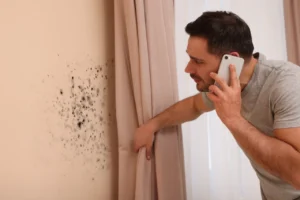
Is It Property Damage or Normal Wear and Tear?
Your tenant’s lease will end soon and they are not going to renew it. Before they move out, you will need to conduct an inspection with them to determine whether any damage has been done to the home during their tenancy.
As you know, a complete rental property inspection should be performed with the tenant present before and after they occupy the unit to keep track of new and existing damage. Be sure to have your camera ready to document anything notable. Each party should keep a copy of the signed checklist for their records to help prevent landlord-tenant problems.
The lease agreement should state that you can deduct expenses from the security deposit to repair tenant-caused damages. Most states don’t have a specific limit for how much landlords can charge for damages, only that the amount must be considered reasonable and itemized in a receipt.
If you find something during your move-out inspection that is different than what appeared on your AAOA move-in checklist, it will be necessary to decide whether it is damage or normal wear and tear. The answer is important because if it’s damage, which often occurs due to carelessness, neglect, or abuse, their security deposit will be affected.
The difference between “Wear and Tear” and “Damages”
City ordinances can be unclear on how to distinguish between normal wear and tear and property damage. It’s very important that you and your tenant understand the difference between them as the answer will determine who is responsible for the cost of correcting it.
Normal wear and tear
Normal wear and tear refers to the natural deterioration that occurs over time due to regular use of the property. The landlord is responsible for wear and tear problems, which are included in their maintenance or tenant turnover expenses.
While the specific damages that can be classified as normal wear and tear varies by state and jurisdiction, the Department of Housing and Urban Development (HUD) provides the following list of examples:
- Slightly torn or faded wallpaper
- Fading, peeling, or cracked paint
- Small chips in plaster
- Nail holes, pin holes, or cracks in wall. Note: According to HUD, nail holes in the walls are considered normal wear and tear. However, it’s reasonable to classify large screw holes or multiple nail holes that cause damage to the paint or drywall as property damage.
- Door sticking from humidity
- Cracked windowpanes from faulty foundation or building settling
- Floors needing coat of varnish
- Carpet faded or worn thin from walking
- Loose grouting and bathroom tiles
- Worn or scratched enamel in old bathtubs, sinks, or toilets
- Rusty shower rod
- Partially clogged sinks caused by aging pipes
- Dirty or faded window shades
Paying Too Much For Insurance?
Get a FREE quote to insure your rental properties for less.
HUD believes that “the costs an owner incurs for the basic cleaning and repairing of such items necessary to make a unit ready for occupancy by the next tenant are part of the costs of doing business.”
As a rule, landlords are responsible for addressing normal wear and tear as part of routine maintenance and preparation for new tenants. It is good practice to do a regular evaluation of your property every three or four months to keep track of normal depreciation and to discover any tenant-caused damage.
Property damage
Per HUD, “Tenant damages usually require more extensive repair, and at greater cost than ‘normal wear and tear’ and are often the result of a tenant’s abuse or negligence that is above and beyond normal wear and tear.”
The tenant is responsible for any property damage found by the landlord during the moving out inspection or routine maintenance checks. Depending on the severity of these damages, this could cause tenants to forfeit part or all of their security deposit, receive a notice to vacate or face eviction.
Below are examples of common damages caused by tenants:
- Gaping holes in walls or plaster
- Drawings, crayon markings, or wallpaper that owner did not approve
- Seriously damaged or ruined wallpaper
- Chipped or gouged wood floors
- Doors ripped off hinges
- Broken windows
- Missing fixtures
- Holes in ceiling from removed fixtures
- Holes, stains, or burns in carpet
- Missing or cracked bathroom tiles
- Chipped and broken enamel in bathtubs and sinks
- Clogged or damaged toilet from improper use
- Missing or bent shower rods
- Torn, stained, or missing lamp and window shades
Is it normal wear and tear or tenant damage?
Sometimes, the cause of damage is not easily determined. Landlords must be able to distinguish between typical deterioration and actual harm done within their properties.
Here are some suggestions to help decide who or what is to blame:
- How old is the rental home? An older home is more likely to suffer from wear and tear than a newer home.
- How long did the tenant live there? The length of tenancy might be a clue to whose fault the damage is.
- Was the damage intentional harm or neglect? This could include holes in a wall, broken windows or missing fixtures. In other words, issues that would not arise without deliberate intent or negligence.
- Did delayed maintenance cause the damage? Leaking pipes or windows that do not shut tightly are conditions that can lead to damaged woodwork or flooring. These are maintenance issues that would have prevented the problem if fixed.
Does pet rent cover pet damages?
Pet rent does not cover damages, but a pet deposit or a pet fee can. If you have charged either of these fees, there are distinct differences between them. Pet deposits are treated like security deposits, but pet fees are one-time and non-refundable. Consult a real estate attorney to learn what laws in your state apply to pet damages and security deposits.
Deducting damage costs from the security deposit
If, at some time during their tenancy, your tenant asks to use all or part of their security deposit as rent, it is best that you do not grant their request. You may need that money to get some tenant-related repairs done after the renter has left the property.
Once you have completed the move-out review with your tenant and they have signed off on it, obtain a contractor’s quote for the cost of fixing any tenant-caused damage. Then subtract the amount from the security deposit and send the itemized deductions to the tenant. Also include any deductions for unpaid rent and utility bills. If you omit this stage and the tenant decides to contest the accusations, they may sue you in small claims court
If the tenant’s security deposit doesn’t cover the cost of repairing all damages, you should address this directly with the tenant to get payment. If the tenant violates lease terms, such as not paying rent or by damaging the property, you can consider filing an eviction.
Any remaining security deposit must be returned to the tenant within a certain amount of time. Since security deposit laws differ in every state, be sure that you conform to the rules for your state.
How to minimize property damage
To avoid tenants with a history of property damage, thoroughly screen your applicants and be sure to include an AAOA Landlord Verification. We will contact your tenant’s current and past landlords and ask the questions you want to know, such as what kind of tenant were they, did they pay their rent on time and did they do any damage to the leased property.













 Accessibility
Accessibility